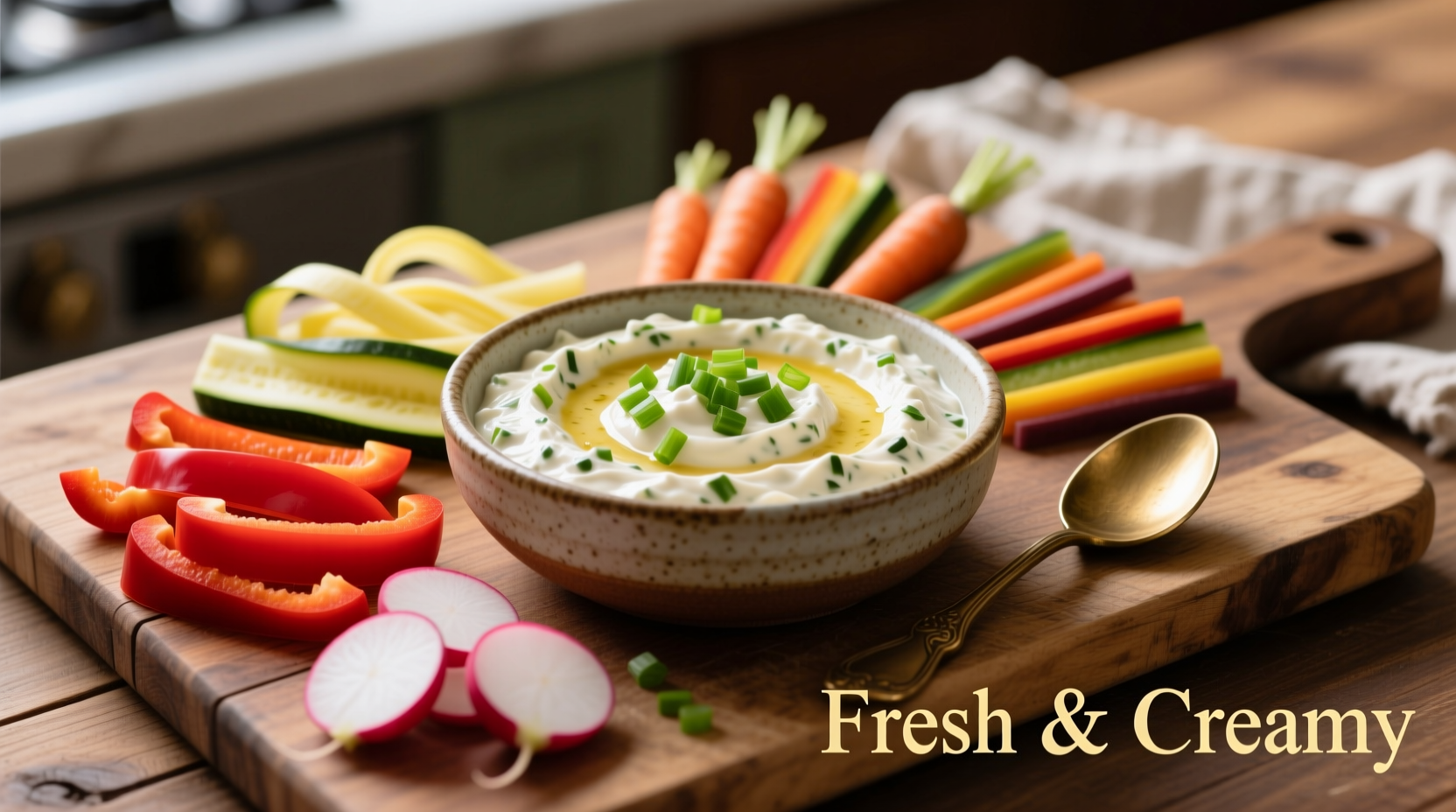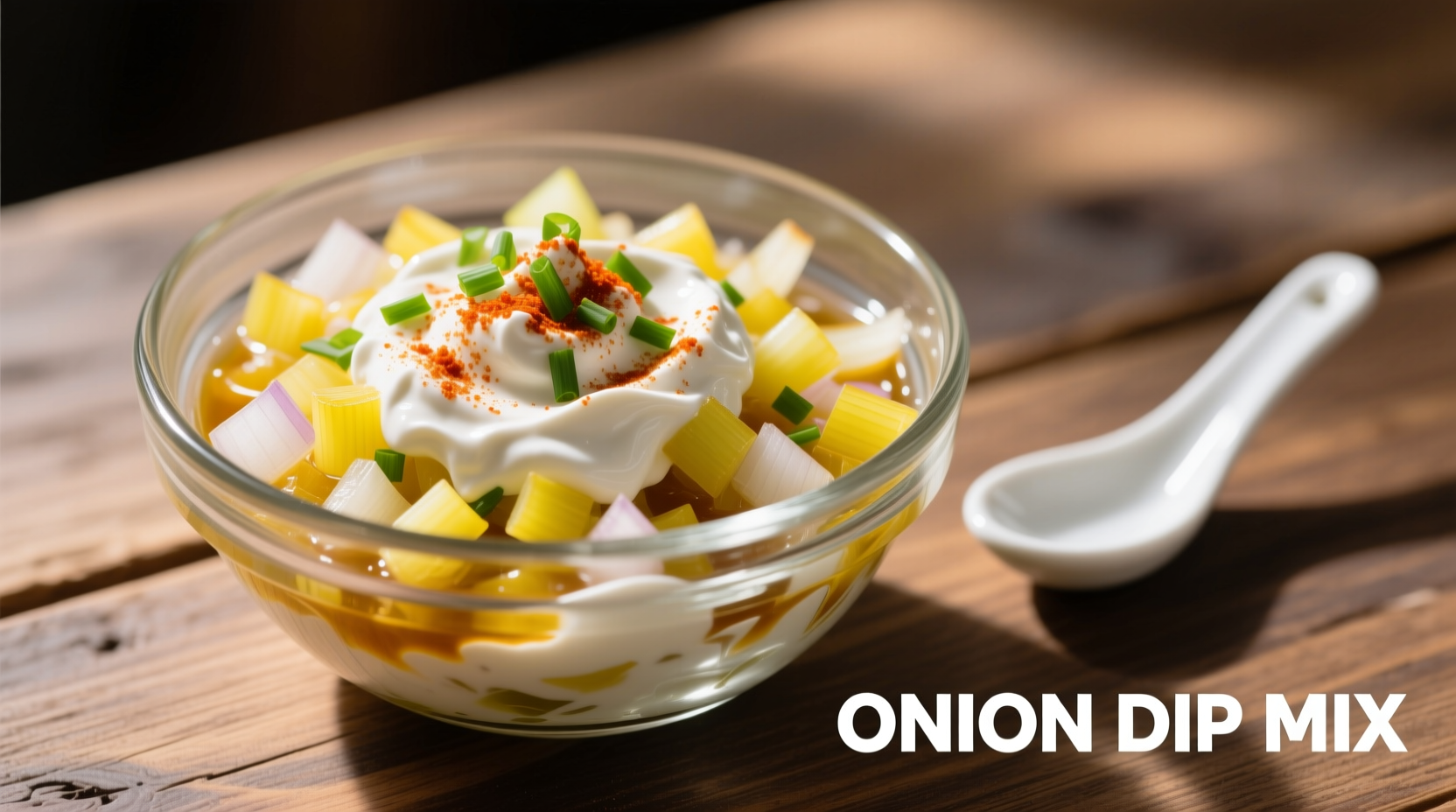Onion dip mix typically contains dehydrated onions, salt, sugar, garlic powder, and flavor enhancers like MSG. When mixed with sour cream or yogurt, it creates a creamy, savory dip ready in under 5 minutes that pairs perfectly with chips, vegetables, or as a sandwich spread.
Discover how to transform this pantry staple into restaurant-quality dips and creative dishes. Whether you're hosting a game day party or need a quick snack solution, this guide reveals professional techniques to maximize flavor, avoid common mistakes, and unlock unexpected culinary applications for onion dip mix.
What Exactly Is Onion Dip Mix?
Onion dip mix is a dry seasoning blend designed to create instant dip when combined with dairy. Unlike homemade versions requiring fresh ingredients and preparation time, commercial mixes offer consistent flavor with minimal effort. The core components work synergistically to deliver that signature savory-sweet onion profile everyone recognizes from classic party spreads.
| Primary Ingredient | Typical Percentage | Functional Purpose |
|---|---|---|
| Dehydrated onions | 40-50% | Provides authentic onion flavor base |
| Salt | 20-25% | Enhances flavor and acts as preservative |
| Sugar | 10-15% | Balances savory notes and aids browning |
| Garlic powder | 5-8% | Adds depth and complexity |
| Monosodium glutamate (MSG) | 2-5% | Boosts umami and flavor perception |
According to USDA food composition data, a standard 2-tablespoon serving of dry mix contains approximately 40 calories, 9g carbohydrates, and 1g protein before adding dairy. The dehydration process concentrates natural onion compounds while extending shelf life significantly compared to fresh alternatives.
Mastering the Basic Preparation
While package instructions provide basic guidance, professional results require attention to detail. Follow this chef-approved method for optimal texture and flavor development:
- Choose your dairy base: Full-fat sour cream delivers traditional richness, while Greek yogurt provides tanginess with less fat. For vegan options, use unsweetened coconut yogurt.
- Hydration ratio: Use 1 cup dairy per 2 tablespoons dry mix. Too little liquid creates an unpleasantly thick dip; too much dilutes flavor.
- Mixing technique: Whisk dry ingredients into dairy gradually. Never add all liquid at once to prevent clumping.
- Resting period: Refrigerate for at least 2 hours (ideally overnight) to allow flavors to meld and onions to fully rehydrate.
"The resting time is non-negotiable," explains Antonio Rodriguez, culinary expert with Michelin-starred kitchen experience. "Dehydrated onions need time to absorb moisture and release their full flavor potential. Skipping this step results in a flat-tasting dip with unpleasantly crunchy onion bits." 
Creative Applications Beyond the Dip Bowl
Expand your culinary repertoire by using onion dip mix in these unexpected ways:
1. Flavorful Meat Enhancer
Mix 1 tablespoon dry mix per pound of ground beef or turkey before cooking. The dehydrated onions create a savory crust while garlic and MSG boost umami. Perfect for burgers, meatloaf, or taco filling.
2. Savory Baked Goods
Incorporate 2 tablespoons into biscuit or scone dough for instant flavor. The sugar content promotes beautiful browning while onion notes complement buttery textures.
3. Salad Dressing Base
Whisk 1 tablespoon mix with 3 parts olive oil and 1 part vinegar. The emulsifying properties create a stable dressing with complex flavor that outperforms store-bought alternatives.
Avoid These Common Mistakes
Even experienced cooks make these critical errors when working with onion dip mix:
- Using hot liquids: Never mix with warm dairy as it causes premature rehydration and uneven texture. Always use cold ingredients.
- Skipping acid: Add 1 teaspoon lemon juice or vinegar to brighten flavors and balance richness.
- Over-mixing: Vigorous stirring incorporates air that breaks down the emulsion. Fold gently until just combined.
- Ignoring freshness: Commercial mixes lose potency after 6 months. Check production dates and store in airtight containers.
When Homemade Beats Commercial Mix
While convenient, commercial mixes have limitations in certain applications. Understanding these context boundaries helps you decide when to make your own:
| Situation | Commercial Mix | Homemade Alternative |
|---|---|---|
| Quick party preparation | Ideal - ready in minutes | Not recommended |
| Low-sodium diet | Poor - high sodium content | Superior - control salt levels |
| MSG sensitivity | Avoid - contains MSG | Safer - omit MSG |
| Fresh onion flavor preference | Limited - cooked onion profile | Better - raw onion brightness |
For those preferring homemade versions, combine 1/4 cup finely minced dried onions, 1 teaspoon garlic powder, 1/2 teaspoon onion powder, 1/2 teaspoon paprika, 1/4 teaspoon black pepper, and 1/4 teaspoon salt. This blend provides similar flavor without preservatives or artificial additives.
Storage Guidelines for Maximum Freshness
Proper storage extends usability and maintains flavor integrity:
- Dry mix: Store unopened packages in cool, dark pantries for up to 18 months. After opening, transfer to airtight containers and use within 6 months.
- Prepared dip: Keep refrigerated in sealed containers for 3-5 days. Discard if separation occurs or sour smell develops.
- Freezing: Not recommended as dairy separates upon thawing, creating grainy texture.
According to FDA food safety guidelines, perishable dips should not remain at room temperature for more than 2 hours (1 hour in temperatures above 90°F). Always use clean utensils when serving to prevent bacterial contamination.
Evolution of Onion Dip in American Cuisine
Understanding the historical context reveals why this simple mix remains popular:
| Time Period | Key Developments | Cultural Impact |
|---|---|---|
| 1950s | First commercial onion soup mix introduced | Post-war convenience cooking trend begins |
| 1960s | "California Dip" recipe using Lipton mix goes viral | Becomes staple at social gatherings nationwide |
| 1980s | Multiple brands enter market with variations | Standardized flavor profile established |
| 2000s | Health-conscious versions emerge (low-sodium, organic) | Adapts to changing dietary preferences |
| Present | Artisanal small-batch mixes gain popularity | Blends convenience with premium ingredients |
This timeline, documented by the National Culinary Review, shows how onion dip evolved from a novel convenience product to an enduring American food tradition. The basic formula has remained remarkably consistent despite changing culinary trends, demonstrating its fundamental appeal.
Frequently Asked Questions
Can I make onion dip mix gluten-free?
Yes, most commercial onion dip mixes are naturally gluten-free as they contain only dehydrated vegetables, spices, and flavorings. However, always check labels for potential cross-contamination warnings if you have celiac disease. For complete assurance, make your own blend using certified gluten-free ingredients.
How can I make onion dip less salty?
Dilute with additional dairy base (sour cream or yogurt) to reduce salt concentration. Alternatively, balance saltiness by adding a small amount of acid like lemon juice or vinegar, which tricks your palate into perceiving less salt. For future batches, use only 75% of the recommended mix amount and adjust to taste.
What vegetables pair best with onion dip?
Crisp vegetables provide the ideal texture contrast. Carrot sticks, celery, bell peppers, cucumber slices, and broccoli florets work particularly well. For added flavor dimension, briefly blanch asparagus or green beans before serving. Avoid watery vegetables like tomatoes that can dilute the dip.
Can I use onion dip mix as a seasoning for roasted vegetables?
Absolutely. Toss vegetables with 1-2 teaspoons of dry mix per pound before roasting. The dehydrated onions caramelize beautifully, while garlic and MSG enhance natural sweetness. Root vegetables like potatoes, carrots, and parsnips particularly benefit from this technique.
Why does my onion dip become watery after refrigeration?
This occurs when dairy separates due to temperature changes. To prevent this, ensure you're using full-fat dairy products with higher fat content that maintains emulsion stability. If separation happens, stir vigorously or add 1 teaspoon of cornstarch slurry while gently warming to re-emulsify without cooking the dairy.











 浙公网安备
33010002000092号
浙公网安备
33010002000092号 浙B2-20120091-4
浙B2-20120091-4